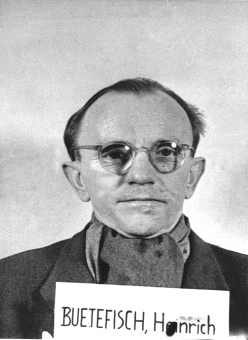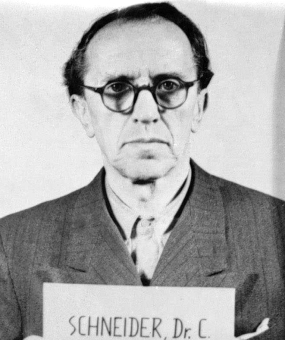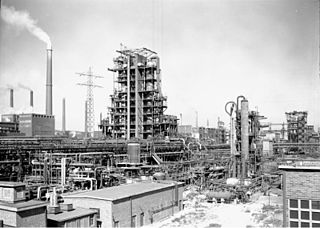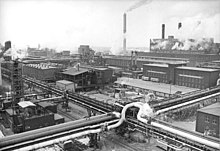
I. G. Farbenindustrie AG, commonly known as IG Farben, was a German chemical and pharmaceutical conglomerate. It was formed in 1925 by merging six chemical companies later known as BASF Aktiengesellschaft, Bayer AG, Hoechst Aktiengesellschaft, Agfa-Gevaert Group, and Cassella AG. The conglomerate was seized by the Allies after World War II and split into its constituent companies; parts in East Germany were nationalized.

Polyacrylonitrile (PAN) is a synthetic, semicrystalline organic polymer resin, with the linear formula (CH2CHCN)n. Almost all PAN resins are copolymers with acrylonitrile as the main monomer. PAN is used to produce large variety of products including ultra filtration membranes, hollow fibers for reverse osmosis, fibers for textiles, and oxidized PAN fibers. PAN fibers are the chemical precursor of very high-quality carbon fiber. PAN is first thermally oxidized in air at 230 °C to form an oxidized PAN fiber and then carbonized above 1000 °C in inert atmosphere to make carbon fibers found in a variety of both high-tech and common daily applications such as civil and military aircraft primary and secondary structures, missiles, solid propellant rocket motors, pressure vessels, fishing rods, tennis rackets and bicycle frames. It is a component repeat unit in several important copolymers, such as styrene-acrylonitrile (SAN) and acrylonitrile butadiene styrene (ABS) plastic.

Allgemeine Elektricitäts-Gesellschaft AG was a German producer of electrical equipment. It was established in 1883 by Emil Rathenau as the Deutsche Edison-Gesellschaft für angewandte Elektricität in Berlin.

The Publicly Owned Enterprise was the main legal form of industrial enterprise in East Germany. These state-owned enterprise were all publicly owned and were formed after mass nationalisation between 1945 and the early 1960s, and the handing back in 1954 of some 33 enterprises previously taken by the Soviet Union as reparations.

Monowitz was a Nazi concentration camp and labor camp (Arbeitslager) run by Nazi Germany in occupied Poland from 1942–1945, during World War II and the Holocaust. For most of its existence, Monowitz was a subcamp of the Auschwitz concentration camp; from November 1943 it and other Nazi subcamps in the area were jointly known as "Auschwitz III-subcamps". In November 1944 the Germans renamed it Monowitz concentration camp, after the village of Monowice where it was built, in the annexed portion of Poland. SS Hauptsturmführer (Captain) Heinrich Schwarz was commandant from November 1943 to January 1945.

Schkopau is a municipality in the Saalekreis district, in Saxony-Anhalt, Germany.

The Schkopau Power Station is a 900 MW lignite-fuelled power station near the Korbetha part of the municipality of Schkopau in the district of Merseburg-Querfurt (Saxony-Anhalt), Germany, which was built in 1995/1996. It has two units with a total capacity of 900 megawatts (MW), of which are 110 MW for traction current with a frequency of 16.7 cycles per second produced in a dedicated generator for Deutsche Bahn AG. In addition, heat is provided for local chemical factories through cogeneration. The power station has a 200 metres (656 ft) high chimney. It is owned and operated by Uniper and EP Energy. The closure is planned for 2034.
The Geisel valley is a valley in Saxony-Anhalt, Germany, situated west of Merseburg, Saalekreis district. It is named after the River Geisel which rises in Mücheln and is a tributary of the Saale, just under 25 km (16 mi) long.

Halle-Neustadt, popularly known as HaNeu, was a city in the German Democratic Republic. It was established as a new town on 12 May 1967, as an independent and autonomous city. The population in 1972 was 51,600 and in 1981 was more than 93,000. On 6 May 1990, Halle-Neustadt merged back into Halle again. The population has halved since then and was about 45,157 inhabitants on 31 December 2010. Halle Neustadt has been praised by the American society ”Thoreau Institute” for being "sustainable" as a result of its urban planning, which includes high density living, a tram line serving the central corridor and the regional suburban rail system (S-Bahn).
The Halle–Bebra railway, known in German as the Thüringer Bahn, is a 210 kilometre-long railway line from Halle (Saale) via Erfurt and Gerstungen to Bebra, mainly in Thuringia. As far as Gerstungen the line originally belonged to the Thuringian Railway Company. From Gerstungen to Bebra, it was owned by the Frederick William Northern Railway (Friedrich-Wilhelms-Nordbahn), named after the Prussian king, Frederick William IV. It is now a two-track, electrified, standard gauge mainline operated by DB Netze. It was opened between 1846 and 1849 and was the first railway line in Thuringia. All types of trains from Regionalbahn to ICE currently run on the line except Interregio-Express. Four of the six largest cities in Thuringia are located on the line.

The Middle German Chemical Triangle is the industrial conurbation around the cities and towns of Halle (Saale), Merseburg and Bitterfeld in the North German state of Saxony-Anhalt and Leipzig and Schkeuditz in the Free State of Saxony. Its name is derived from the dominant industries of the region – the chemical and oil refining industries.

Otto Ambros was a German chemist and Nazi war criminal. He is known for his wartime work on synthetic rubber and nerve agents. After the war he was tried at Nuremberg and convicted of crimes against humanity for his use of slave labor from the Auschwitz III–Monowitz concentration camp. In 1948 he was sentenced to 8 years' imprisonment, but released early in 1951 for good behavior.

Heinrich Bütefisch was a German chemist, manager at IG Farben, and Nazi war criminal. He was an Obersturmbannführer in the SS.

Christian Schneider was a Nazi German chemist, industrial manager and, in the Third Reich, a Wehrwirtschaftsführer. He was tried, and ultimately acquitted, for war crimes his role in the Holocaust.
Technische Hochschule „Carl Schorlemmer“ Leuna-Merseburg, abbreviated: THLM was an institution of tertiary education in the city of Merseburg in today's Saxony-Anhalt, Germany. It was founded on 1 September 1954 as Technische Hochschule für Chemie Leuna-Merseburg (THC) and closed on 31 March 1993. Hochschule Merseburg was founded on the grounds of THLM in 1992.

The Leuna works in Leuna, Saxony-Anhalt, is one of the biggest chemical industrial complexes in Germany. The site, now owned jointly by companies such as TotalEnergies, BASF, Linde plc, and DOMO Group, covers 13 km2 and produces a very wide range of chemicals and plastics.

The Merseburg–Halle-Nietleben railway is an about 19 kilometre-long electrified branch line in the German state of Saxony-Anhalt. A second track exists between Merseburg and Merseburg-Elisabethhöhe and between Halle-Zscherbener Straße and Halle-Nietleben. Part of the current route was built in 1967 with a significant realignment of the Zwiebelbahn on the (Merseburg–) Bad Lauchstädt–Angersdorf route.

Marl Chemical Park is an industrial park in Marl, North Rhine-Westphalia, Germany. It is the third largest industrial cluster in Germany and among the largest chemical production facilities in Europe. The site occupies over 6 square kilometers, hosts 100 chemical plants, employs 10,000 people, and produces 4 million metric tons of chemicals annually. 18 companies are based in the Park, including primary tenant Evonik Industries AG, which also owns and operates the infrastructure through its subsidiary Infracor GmbH.

SV Merseburg 99 is a sports club from Merseburg in Saxony-Anhalt. The club has existed since August 23, 1899. The club colors are green and white. The club's home base is the Merseburg City Stadium.



















